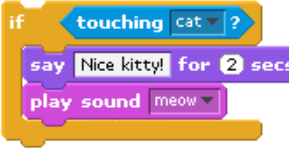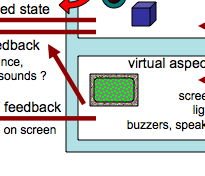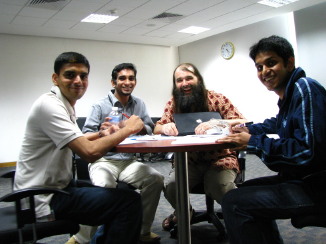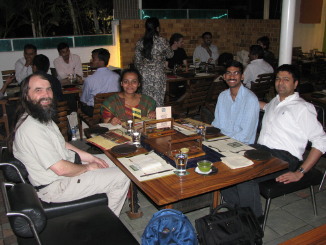A few days ago our neighbour told us this joke:
“Why did the dinosaur cross the road?”
…
It reminded me yet again of the incredible richness of apparently trivial day-to-day thought. Not the stuff of Wittgenstein or Einstein, but the ordinary things we think as we make our breakfast or chat to a friend.
There is a whole field of study looking at computational humour, including its use in user interfaces1, and also on the psychology of humour dating back certainly as far as Freud, often focusing on the way humour involves breaking the rules of internal ‘censors’ (logical, social or sexual) but in a way that is somehow safe.
Of course, breaking things is often the best way to understand them, Graeme Ritchie wrote2:
“If we could develop a full and detailed theory of how humour works, it is highly likely that this would yield interesting insights into human behaviour and thinking.”
In this case the joke starts to work, even before you hear the answer, because of the associations with its obvious antecessor3 as well as a whole genre of question/answer jokes: “how did the elephant get up the tree?”4, “how did the elephant get down from the tree?”5. We recall past humour (and so neurochemically are set in a humourous mood), we know it is a joke (so socially prepared to laugh), and we know it will be silly in a perverse way (so cognitively prepared).
The actual response was, however, far more complex and rich than is typical for such jokes. In fact so complex I felt an almost a palpable delay before recognising its funniness; the incongruity of the logic is close to the edge of what we can recognise without the aid of formal ‘reasoned’ arguments. And perhaps more interesting, the ‘logic’ of the joke (and most jokes) and the way that logic ‘fails’, is not recognised in calm reflection, but in an instant, revealing complexity below the level of immediate conscious thought.
Indeed in listening to any language, not just jokes, we are constantly involved in incredibly rich, multi-layered and typically modal thinking6. Modal thinking is at the heart of simple planning and decision making “if I have another cake I will have a stomach ache”, and when I have studied and modelled regret7 the interaction of complex “what if” thinking with emotion is central … just as in much humour. In this case we have to do an extraordinary piece of counterfactual thought even to hear the question, positing a state of the world where a dinosaur could be right there, crossing the road before our eyes. Instead of asking the question “how on earth could a dinosaur be alive today?”, we are instead asked to ponder the relatively trivial question as to why it is doing, what would be in the situation, a perfectly ordinary act. We are drawn into a set of incongruous assumptions before we even hear the punch line … just like the way an experienced orator will draw you along to the point where you forget how you got there and accept conclusions that would be otherwise unthinkable.
In fact, in this case the punch line draws some if its strength from forcing us to rethink even this counterfactual assumption of the dinosaur now and reframe it into a road then … and once it has done so, simply stating the obvious.
But the most marvellous and complex part of the joke is its reliance on perverse causality at two levels:
temporal – things in the past being in some sense explained by things in the future8.
reflexive – the explanation being based on the need to fill roles in another joke9.
… and all of this multi-level, modal and counterfactual cognitive richness in 30 seconds chatting over the garden gate.
So, why did the dinosaur cross the road?
“Because there weren’t any chickens yet.”
- Anton Nijholt in Twente has studied this extensively and I was on the PC for a workshop he organised on “Humor modeling in the interface” some years ago, but in the end I wasn’t able to attend :-([back]
- Graeme Ritchie (2001) “Current Directions in Computer Humor”, Artificial Intelligence Review. 16(2): pages 119-135[back]
- … and in case you haven’t ever heard it: “why did the chicken cross the road?” – “because it wanted to get to the other side”[back]
- “Sit on an acorn and wait for it to grow”[back]
- “Stand on a leaf and wait until autumn”[back]
- Modal logic is any form of reasoning that includes thinking about other possible worlds, including the way the world is at different times, beliefs about the world, or things that might be or might have been. For further discussion of the modal complexity of speech and writing, see my Interfaces article about “writing as third order experience“[back]
- See “the adaptive significance of regret” in my essays and working papers[back]
- The absence of chickens in prehistoric times is sensible logic, but the dinosaur’s action is ‘because ‘ they aren’t there – not just violating causality, but based on the absence. However, writing about history, we might happily say that Roman cavalry was limited because they hadn’t invented the stirrup. Why isn’t that a ridiculous sentence?[back]
- In this case the dinosaur is in some way taking the role of the absent chicken … and crossing the Jurassic road ‘because’ of the need to fill the role in the joke. Our world of the joke has to invade the dinosaur’s word within the joke. So complex as modal thinking … yet so everyday.[back]









